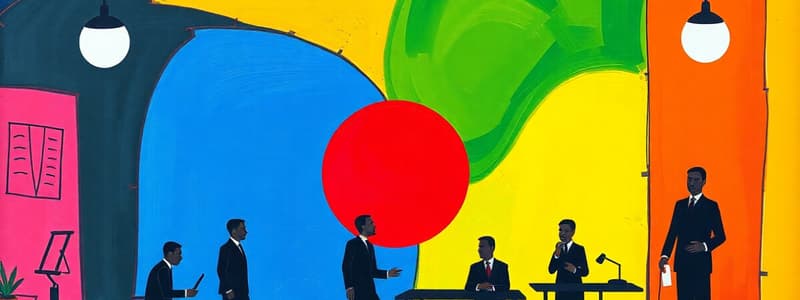Podcast
Questions and Answers
A multinational corporation, renowned for its stringent adherence to espoused values of environmental sustainability, launches a marketing campaign that prominently features its environmentally friendly practices. However, internal audits reveal that a significant proportion of its manufacturing processes still rely on unsustainable methods. Which of the following best characterizes this scenario within the context of organizational culture?
A multinational corporation, renowned for its stringent adherence to espoused values of environmental sustainability, launches a marketing campaign that prominently features its environmentally friendly practices. However, internal audits reveal that a significant proportion of its manufacturing processes still rely on unsustainable methods. Which of the following best characterizes this scenario within the context of organizational culture?
- A culturally insulated system, where internal operations are shielded from external scrutiny.
- Cultural dissonance, where enacted values contradict the publicly espoused values, potentially leading to stakeholder distrust and reputational damage. (correct)
- High cultural congruence, as the espoused values are effectively communicated externally.
- Cultural ambidexterity, reflecting the organization's ability to simultaneously pursue conflicting values.
An engineering firm widely promotes values of innovation and experimentation but consistently penalizes employees for failed projects, regardless of their potential for learning and future success. How would this discrepancy manifest within Schein's model of organizational culture?
An engineering firm widely promotes values of innovation and experimentation but consistently penalizes employees for failed projects, regardless of their potential for learning and future success. How would this discrepancy manifest within Schein's model of organizational culture?
- Reinforcement of artifacts through consistent reward systems.
- A cultural shift that prioritizes stability over innovation.
- Misalignment between espoused values and enacted values, impacting the fundamental, unconscious beliefs (basic assumptions) driving employee behavior. (correct)
- Alignment between espoused values and basic assumptions.
In an organization aiming to foster a culture of collaboration and open communication, management implements a hierarchical office layout with closed-off cubicles, restricts cross-departmental interactions, and discourages dissenting opinions in meetings. Which element of organizational culture, being incongruent with the espoused values, is most directly manifest in this scenario?
In an organization aiming to foster a culture of collaboration and open communication, management implements a hierarchical office layout with closed-off cubicles, restricts cross-departmental interactions, and discourages dissenting opinions in meetings. Which element of organizational culture, being incongruent with the espoused values, is most directly manifest in this scenario?
- Basic assumptions, reflecting deeply ingrained beliefs about efficiency.
- Enacted values, demonstrated through consistent alignment with stated principles.
- Artifacts, as the physical environment and formal structures contradict the stated goals. (correct)
- Espoused values, promoting transparency and collaborative efforts.
A highly successful tech company known for innovation decides to implement a new performance management system that heavily emphasizes individual performance metrics and competition among teams, while simultaneously promoting the ideal of teamwork in its mission statement. How would this shift likely affect the organization's culture?
A highly successful tech company known for innovation decides to implement a new performance management system that heavily emphasizes individual performance metrics and competition among teams, while simultaneously promoting the ideal of teamwork in its mission statement. How would this shift likely affect the organization's culture?
An organization that explicitly values ethical behavior and corporate social responsibility experiences frequent incidents of internal corruption and unethical practices. Which of the following frameworks would best describe this situation?
An organization that explicitly values ethical behavior and corporate social responsibility experiences frequent incidents of internal corruption and unethical practices. Which of the following frameworks would best describe this situation?
Which of the following mechanisms is most likely to enforce and sustain an organizational culture characterized by relentless innovation, risk-taking, and minimal adherence to established protocols?
Which of the following mechanisms is most likely to enforce and sustain an organizational culture characterized by relentless innovation, risk-taking, and minimal adherence to established protocols?
A hyper-competitive organization with a culture of relentless pursuit of outcomes implements a policy that mandates regular employee feedback sessions focused solely on identifying individual performance gaps and areas for immediate improvement, while neglecting positive reinforcement or developmental coaching. How would this policy likely influence the organizational culture?
A hyper-competitive organization with a culture of relentless pursuit of outcomes implements a policy that mandates regular employee feedback sessions focused solely on identifying individual performance gaps and areas for immediate improvement, while neglecting positive reinforcement or developmental coaching. How would this policy likely influence the organizational culture?
In an organization with a deeply ingrained culture of teamwork and collaboration, a recently appointed CEO, without consulting employees, decides to dismantle team-based structures in favor of individual performance contracts and competitive rankings. What is the most likely consequence of this abrupt change on organizational culture?
In an organization with a deeply ingrained culture of teamwork and collaboration, a recently appointed CEO, without consulting employees, decides to dismantle team-based structures in favor of individual performance contracts and competitive rankings. What is the most likely consequence of this abrupt change on organizational culture?
A global corporation, celebrated for its cutting-edge innovation in sustainable technologies, actively promotes a culture of environmental stewardship and social responsibility. However, it outsources its manufacturing to developing countries with lax environmental regulations, resulting in significant pollution and exploitation of local communities. Which outcome would best describe this scenario?
A global corporation, celebrated for its cutting-edge innovation in sustainable technologies, actively promotes a culture of environmental stewardship and social responsibility. However, it outsources its manufacturing to developing countries with lax environmental regulations, resulting in significant pollution and exploitation of local communities. Which outcome would best describe this scenario?
Within the context of organizational culture, what critical role does the consistent and transparent communication of values by leadership play in shaping employee behavior and attitudes?
Within the context of organizational culture, what critical role does the consistent and transparent communication of values by leadership play in shaping employee behavior and attitudes?
A large retail organization explicitly states its commitment to customer satisfaction and employee empowerment. However, store managers are frequently penalized for empowering employees to resolve customer issues independently and are instead pressured to adhere strictly to standardized procedures, regardless of customer needs. Which of the following is the most likely outcome of this cultural incongruence?
A large retail organization explicitly states its commitment to customer satisfaction and employee empowerment. However, store managers are frequently penalized for empowering employees to resolve customer issues independently and are instead pressured to adhere strictly to standardized procedures, regardless of customer needs. Which of the following is the most likely outcome of this cultural incongruence?
An organization with a long-standing tradition of open communication and collaborative decision-making acquires a smaller company known for its hierarchical structure and top-down management style. Which approach would best facilitate the integration of the two distinct organizational cultures?
An organization with a long-standing tradition of open communication and collaborative decision-making acquires a smaller company known for its hierarchical structure and top-down management style. Which approach would best facilitate the integration of the two distinct organizational cultures?
Over a sustained period, an organization’s performance has steadily declined, characterized by low employee morale, resistance to change, and a lack of innovation. How can organizational culture contribute to reversing this decline?
Over a sustained period, an organization’s performance has steadily declined, characterized by low employee morale, resistance to change, and a lack of innovation. How can organizational culture contribute to reversing this decline?
A software development company operating in a rapidly evolving technological landscape explicitly aims to cultivate a culture of continuous learning and adaptation. Which of the following strategies would be most effective in reinforcing this culture?
A software development company operating in a rapidly evolving technological landscape explicitly aims to cultivate a culture of continuous learning and adaptation. Which of the following strategies would be most effective in reinforcing this culture?
Imagine a scenario where a merger occurs between two technologically advanced firms. Firm A prides itself on its decentralized decision-making processes and encourages experimentation, while Firm B operates on a centralized, hierarchical system. What integrated strategy will likely yield the most synergistic cultural blending?
Imagine a scenario where a merger occurs between two technologically advanced firms. Firm A prides itself on its decentralized decision-making processes and encourages experimentation, while Firm B operates on a centralized, hierarchical system. What integrated strategy will likely yield the most synergistic cultural blending?
What strategy best enables an established, risk-averse organization to cultivate a subculture championing radical innovation without disrupting the stability of its core operations?
What strategy best enables an established, risk-averse organization to cultivate a subculture championing radical innovation without disrupting the stability of its core operations?
What action would be MOST effective in creating a culture where speaking out against unethical practices is not only permitted but rewarded?
What action would be MOST effective in creating a culture where speaking out against unethical practices is not only permitted but rewarded?
In an environment marked by rapid technological change and shifting market conditions, which approach is most suitable for building a resilient organizational culture?
In an environment marked by rapid technological change and shifting market conditions, which approach is most suitable for building a resilient organizational culture?
Which of the following approaches would MOST effectively alter fundamental basic assumptions within an organization?
Which of the following approaches would MOST effectively alter fundamental basic assumptions within an organization?
How does an organization with consistently aligned values create an ethically centered environment?
How does an organization with consistently aligned values create an ethically centered environment?
Flashcards
Organisational Culture
Organisational Culture
Shared values, beliefs, norms, and practices shaping behavior and attitudes.
Espoused Values
Espoused Values
The company's stated values.
Enacted Values
Enacted Values
Values that are demonstrated in practice.
Artifacts (Visible Culture)
Artifacts (Visible Culture)
Signup and view all the flashcards
Basic Assumptions
Basic Assumptions
Signup and view all the flashcards
Diagnosing Culture
Diagnosing Culture
Signup and view all the flashcards
Aligned Values
Aligned Values
Signup and view all the flashcards
Ethical Culture
Ethical Culture
Signup and view all the flashcards
Values
Values
Signup and view all the flashcards
Innovation (Culture)
Innovation (Culture)
Signup and view all the flashcards
Stability (Culture)
Stability (Culture)
Signup and view all the flashcards
Respect for People
Respect for People
Signup and view all the flashcards
Outcome Orientation
Outcome Orientation
Signup and view all the flashcards
Attention to Detail
Attention to Detail
Signup and view all the flashcards
Team Orientation
Team Orientation
Signup and view all the flashcards
Aggressiveness
Aggressiveness
Signup and view all the flashcards
Coercive power
Coercive power
Signup and view all the flashcards
Organizational Politics
Organizational Politics
Signup and view all the flashcards
Changing Artifacts
Changing Artifacts
Signup and view all the flashcards
Positive Outcomes
Positive Outcomes
Signup and view all the flashcards
Study Notes
- Organisational culture is defined as the shared values, beliefs, norms, and practices shaping the behavior and attitudes of people within an organization.
- Organisational culture provides identity and meaning to employees, influences decision-making and performance, and affects employee retention, motivation, and productivity.
Schein's Model
- Schein's model explains the types of organisational culture
Artefacts (Visible Culture)
- Physical structures, rituals, language, and dress code are examples of visible artifacts.
- Google's open office layout is an example to encourage collaboration.
Espoused and Enacted Values
- Espoused values are what a company states it values.
- Enacted values are what actually occurs in practice.
- A company claiming open communication but discouraging dissent is an example of mismatch between espoused and enacted values.
Basic Assumptions
- Deeply ingrained beliefs about work, people, and relationships form basic assumptions.
- Some organizations assume employees work best independently, while others promote teamwork.
Positive vs. Negative Organisational Culture
- High employee satisfaction, lower turnover, and strong teamwork indicate a positive organizational culture.
- Netflix's encouragement of autonomy and accountability is an example.
- Resistance to change, toxic environments including bullying or fear, and groupthink signify a negative organizational culture.
- Uber's toxic culture is an example, leading to high-profile resignations.
Diagnosing Organizational Culture
- Office design and rituals are artefacts.
- Stories and symbols show how the company celebrates success.
- Dress code and communication style are examples of norms and behaviors.
- Amazon: performance-driven, high-pressure
- Ryanair: Cost-cutting, strict policies
Cultural Alignment & Ethics
- Companies where espoused values align with enacted values foster trust.
- An ethical culture ensures fairness, diversity, and inclusion.
- Patagonia promotes environmental responsibility and follows through with sustainable practices.
MCQ related to Takata
- When debate is not encouraged and groupthink prevails, this suggests a mismatch between espoused and enacted values.
MCQ related to Green Corp
- A company that likes to experiment, take risks and has few rules, indicates innovation.
Reading Assignment - Week 10
- Values are stable, evaluative beliefs that guide preferences for outcomes or actions.
- Drawbacks of organizational culture models include the idea that they are clear and unified, not accounting for shared assumptions, and oversimplifying cultural values.
- Corporate culture consists of values and assumptions and provides a template for how employees behave.
- Values are enacted when they lead action.
- Ethical practices often reflect the dominant values of the organization.
- Changing artifacts like reward systems and workplace layout can alter or strengthen the corporate culture.
Tutorial MCQ on Noncompliance
- The ability to punish is referred to as coercive power.
Organisational Politics definition
- Defined as using influence tactics for personal gain at the perceived expense of others.
Studying That Suits You
Use AI to generate personalized quizzes and flashcards to suit your learning preferences.




